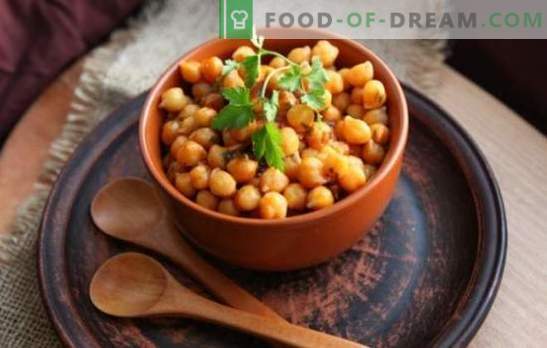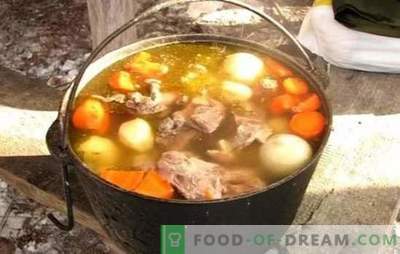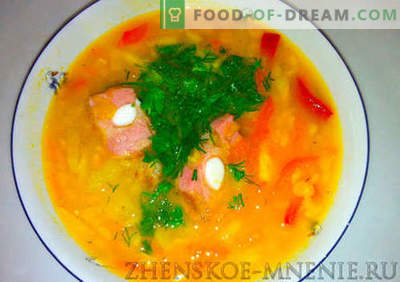
A very ancient and close "relative" of peas - chickpeas. The plant is too thermophilic for growing in temperate latitudes, so for seven and a half thousand years, becoming the food of Roman aristocrats and legionaries, oriental dervishes, kings, sultans and simple poor, “mutton peas” is still a rather rare guest in European cuisine, despite its interesting and useful benefits.
In modern world culinary, chickpeas, as one of vegetable crops, firmly hold positions in North Africa, Western and Central Asia, Turkey, Pakistan and India, in North America and Mexico. Recently, its popularization in the southern regions of Russia has puzzled and domestic breeders, and once scientists have paid attention to the vegetable and have already brought some varieties, this fact definitely indicates the benefit of the product.
In our kitchen, chickpea dishes are, in a sense, exotic legumes. You can buy it, but chickpeas are twice as expensive as peas with the resemblance. That's because, even venturing to try it out of curiosity, housewives often wonder how to make chickpea, how does it differ from ordinary peas, and what dishes can be cooked from it?
Let's try to figure out and answer these questions.
How much to cook chickpeas after soaking: we study the useful composition
Agree to buy a kilogram of peas, even if exotic, for the price of two kilograms, requires a serious incentive. In fact, what is valuable in this nut, apart from the cost of export, and why has humanity not forgotten about it for 7.5 thousand years?
It is noteworthy that dried chickpea peas contain up to 60% of “light” carbohydrates, up to 25% protein, similar in structure to egg, and up to 4% of fats, which give the product a nutty flavor and aroma. We pay special attention to the “light carbohydrates” and emphasize that it is the egg white that is completely absorbed by the body, not accumulating in the form of unwanted deposits. Sprouted chickpea seeds fully satisfy the daily human need for vitamins A and C, and in dried fruit - a complete set of vitamins of the BB group, folic, nicotinic, pantothenic acid, vital lysine - more than eighty components in total, including also the minerals potassium and calcium, magnesium, phosphorus, manganese and iron. Perhaps, from the entire periodic table, the chickpea fruit does not include only elements harmful to humans. That's what chickpeas are! Yes, I almost forgot about our usual peas. He, of course, is also not deprived of nature in terms of usefulness, but is much more nutritious, and in its composition there are saturated fatty acids. So, in terms of proper nutrition, dietary components of chickpea are more interesting.
How to cook chickpeas - choose the product
Chickpea seeds are grown not only for food purposes. Culture is widely used in animal husbandry. From here there is chickpeas of the first and second type. We are interested in chickpeas of the first type - food varieties, with a color palette from white to yellow-pink shades. All other species, from red to brown, are intended for other purposes, and in their packaging should not be, as well as other impurities in the form of small stones, pieces of stems or some other incomprehensible inclusions.
As for the country of manufacture, which should be indicated on the package, then you need to understand that imported chickpeas, of course, will cost more, but there is one nuance that we should not forget: the soil, the climate - everything that they eat and breathe plants, creates a taste of fruit. You can create absolutely similar and necessary conditions for growing, but a lemon in a flower pot in the Arctic Circle will still be different from a lemon grown in a tropical climate, like any plant, including chickpeas. So, the choice is between price and quality.
How much to cook chickpeas after soaking and what to cook?
Consider the issue of cooking technology of legumes, let's start with the most important feature of this product, significantly affecting the preparatory stage of processing before cooking chickpea dishes.
Dishes from legumes cause swelling in many in the process of digestion. This is the fault of oligosaccharides, which are part of all leguminous crops. Reacting with gastric juice, oligosaccharides emit gas that irritates the walls of the gastrointestinal tract, causing discomfort. For this reason, many people often refuse to eat all kinds of peas and beans. The situation can be corrected at the initial stage of preparation. Preliminary preparation of chickpeas consists in thorough washing and soaking the seeds. This process has two goals.
Firstly, after swelling in water and increasing 2-2.5 times in volume, the cooking time of chickpea is significantly reduced, and if it takes, on average, two and a half hours to cook without soaking, prepared chickpeas cooked for 1.5 hours.
Secondly, those same oligosaccharides that create problems in digestion of food, when soaking, interact with water, which, reacting with them, causes the breakdown of sugars and causes the beginning of fermentation and carbon dioxide evolution before it starts digestive process.
Soaking time - 10-12 hours, but necessarily - in cool water, not higher than 150 ° C, so that yeast fermentation does not begin, given the high sugar content in the beans. In addition, it is desirable to change the water 2-3 times to partially remove carbohydrates and make chickpea even more dietary product.
Duration of cooking from 1.5 to 2 hours, depending on the required degree of cooking. The ratio of water and chickpea when cooking - 1 part of the seed to 2.5 parts of water. Cook peas, dropping in cold water. But the specified amount of water is only necessary for cooking the peas. When boiling a foam is formed, which must be removed, which has to be done along with part of the water. Therefore, add a little more water - as a last resort, the excess can then be drained after cooking.
Chickpea dishes are very popular in Oriental and Asian cuisine. This product is an indispensable ingredient in diet and vegetarian cuisine.
Chickpea puree with butter and herbs can be a pie filling, and can also be a great side dish for meat and vegetable dishes. Chickpea, like all types of peas, serves as a good thickener for mashed soups. Chickpea puree is added to the dough or used as a filling for the pies.
1. How to cook chickpeas: cream soup, vegetarian
Products:
- Onions, bulb 120 g
- Yellow carrot 100 g
- Potatoes 250 g
- Olive oil 100 ml
- Celery (root) 50 g
- Garlic 30 g
- Chickpeas 200 g
- Butter, cream 90 g
- Parsley and dill 50 g
Spices:
- curry,
- red and black ground pepper,
- bay leaf
- Salt
- Water 2.4 L
Cooking:
Prepare the chickpeas as described above. Boil it until tender. In a pan with boiled chickpeas add cubes of peeled and finely chopped potatoes. Keep cooking. Finely chop the onion, carrot and celery and sauté in the heated olive oil until soft, then add to the pan with vegetables. Crush the garlic and, along with the spices and salt, season them with the soup. Pour the contents of the pan into the bowl of the blender and perebeyte until smooth. Pour the finished soup back into the pan, add the butter and chopped greens. Bring to a boil, immediately remove from heat.
2. How much to cook chickpeas after soaking for a salad with beets and pomegranate
Composition:
- Beetroot, boiled 300 g
- Boiled chickpeas 150 g
- Pomegranate seeds 100 g
- Fried sesame
- Parsley
- Red, sweet onions
Refueling:
- Lemon juice
- Peanut Oil (or Olive)
- Spices
Cooking:
Boil chickpea to softness, but do not overcook, drain water, cool. Cut beetroot and onion thinly into straws. Clean the pomegranate seeds. Combine all the ingredients in a salad bowl, pour the cooked dressing, mix, decorate with greens and sesame seeds.
3. How to boil chickpeas - pea filling for yeast pies, fried
Composition of products:
- Pea puree 400 g
- Butter, melted 70 g
- Vegetable fat 50 g
- Spices to taste.
- Garlic 50 g
- Greens 100 g
- Onion 180g
- Salt
Cooking:
Cook mashed hot chickpeas, stretching it to a uniform consistency. In hot mashed potatoes, add melted butter, chopped greens and garlic, fried in vegetable oil, onion cut into small cubes. Bring to taste your favorite spices. Stir.
It is an excellent filling for pies, samos and other savory dough products, but also such filling is tasty in itself, as a separate dish or side dish. It looked like porridge from chickpeas in ancient Rome.
How to make chickpeas - useful tips
- If in the process of chickpea cooking it turned out that the water turned out to be not enough, then only boiling water can be added. When cold water is added, the peas are worse boiled soft and the grains lose their shape.
- Salt when cooking peas is added only at the very end, when it is completely boiled soft.
- Some housewives add baking soda in the soaking process or in boiling water to speed up the chickpea cooking process. Please note that the taste of the product and the finished dish is noticeably worse when using this technique.
- Water in which the chickpeas were soaked can be used to feed indoor plants.























